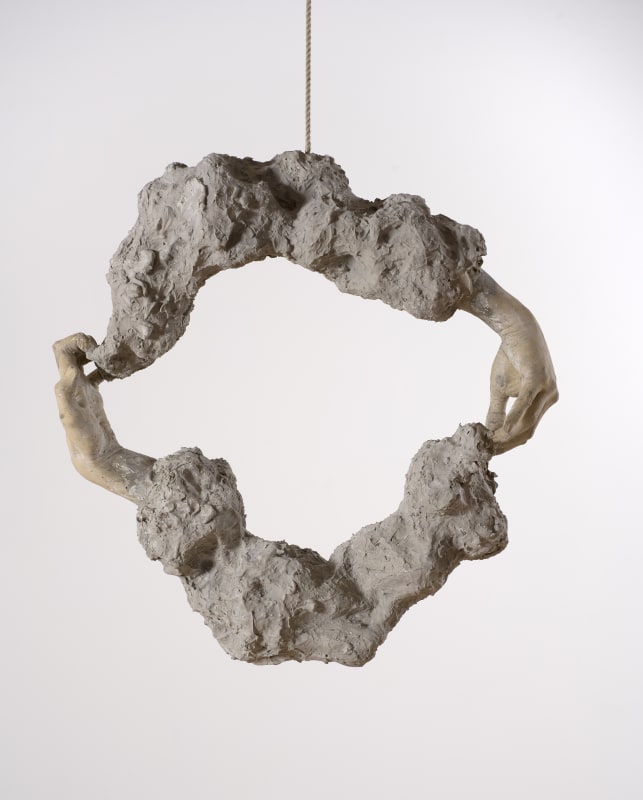Zoe Ettinger talks to artist William Cobbing about his first solo exhibition in London in four years, 'Haptic Loop' at Cooke Latham Gallery.
"The struggle itself towards the heights is enough to fill a man's heart. One must imagine Sisyphus happy." -Albert Camus, The Myth of Sisyphus
If you haven't read Albert Camus' essay, 'The Myth of Sisyphus', here I will provide a brief synopsis, as it will aid in your understanding of the work of William Cobbing. Sisyphus was a king in Greek mythology, notorious for his ability to cheat death. Through his trickery, he angered the god Zeus, and he punished Sisyphus to an eternal purgatory in which he had to roll a boulder up a hill only to have it roll back down again each time. Camus uses Sisyphus' toil as an allegory for the absurdity of life, as he believed that the ends of our everyday tasks were meaningless. So how could we imagine Sisyphus happy? Well, Camus asks us to find the beauty in the mundane, to take joy in the process-to feel accomplishment in our brief moments of success.
William Cobbing seeks to embody Camus' philosophy, known as absurdism, through his sculptural work. As I enter the gallery to begin our interview, things are en medias res, as Cobbing is preparing for his exhibition. It is a fitting start on my journey to understanding absurdism- seeing beauty in the routine.
In the large airy space, my eye is drawn first to his hand sculptures. Through two key mediums, clay and bronze, Cobbing creates casts of his hands. These forensically correct casts appear eerily human, as if a hand was actually trapped inside. He explains that the casts were created using alginate, the same material they use to make jaw moulds for braces. The hands and hunks of finger-manipulated clay are used to create rings and loops, the fingers ever-reaching for one another and something else. They provide a very intentional sense of unsettlement, based on Cobbing's interpretation of the Freudian term known as the uncanny. Cobbing explains: "It is not horror nor gore, but a sort of subtler sense of unease based in the everyday."
Freud first used the uncanny to describe dolls and waxworks. In them he found a strange familiarity, a sinister sort of déjà vu. I was able to experience this feeling firsthand watching Cobbing's videos, in which men dressed in normal clothing have their heads covered in gigantic clay helmets. Their clothing is familiar, and the clay not horrific, but certainly strange. Then the men write (and subsequently erase) words on the 'faces' of one another: what, grrr, move and come-it's as if we can hear coming from a human mouth. Through this process, Cobbing seeks to create a commentary on communication in the modern era. "I was thinking about the idea of the physicality of language, and I suppose if you're texting, it's so readily available online, but I like the idea of slowing it down, like walking through a swamp. You're linking it to the physical material, and what you're left with is a palimpsest echo of the previous text."
Cobbing's videos are to be displayed on large screens and to run consecutively through the duration of the display, ambient films to go along with the sculptures. They represent another interpretation of the exhibition's name, Haptic Loop. Haptic refers to any sort of interaction involving touch and the loop is, as Cobbing explains it, "a sort of narrative that doesn't have a start and an end. Something is, in a way, never resolved. With these works, it's a kind of question of a work that's infinitely in motion."
Another major part of Cobbing's work is the clay book covers he creates. In what I can only describe as a lumpy grey mound of clay, he places a series of correctly-sized covers. Their meanings are various, some come from authors he knows and loves, some are written by friends, some suggested by others, but all seem to have an interpersonal connection for him. Stuck in this hunk are pieces of his past, reminders of loved ones and people he admires. One that catches my eye is The Foundations of Judo by Yves Klein. "I really love the book, I love the concept that it's a training manual to learn Judo. My friend suggested it to me, his daughter is learning judo." It's a moment in which I can see the human connection to the work, the beauty he finds in his creation- I think I'm starting to understand what Camus was talking about.
The interview finishes as we complete our haptic loop, returning to Sisyphus. On the back wall of the gallery, Cobbing has re-created 10 of the famous covers of Camus' work. The covers are from either the original French or English translation and they range in year published, yet each one has an image of a boulder, the representation of Sisyphus' slog. We look at one cover that pictures a man is in a box below the boulder. To me it appears claustrophobic, but to Cobbing: "this is how a really good night's sleep feels to me, a bit like, I'm at the bottom of an ocean, so deeply in ensconced in something." I have to say, I find his interpretation absurd.

